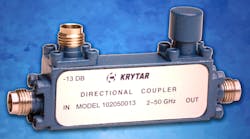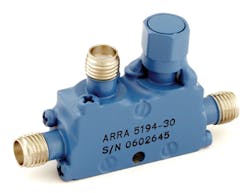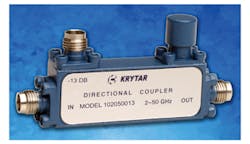This file type includes high resolution graphics and schematics when applicable.
Couplers can be thought of as RF/microwave “samplers,” components that can extract a small portion of a high-frequency signal without significantly altering the main signal. Couplers are constructed using a variety of different technologies and housed in different package styles, but one trend dominates (as with electronic components in general): decreasing size.
More and more high-frequency couplers are being developed in surface-mount package formats to save space on high-frequency circuits. But couplers can be useful in many different formats, and the usual tradeoff for size is power-handling capabilities. Larger couplers handle higher power levels than miniature surface-mount-technology (SMT) components.
Couplers for RF/microwave applications come in many forms and technologies, including with microstrip, stripline, waveguide, and low-temperature-cofired-ceramic (LTCC) construction. Directional couplers are among the most popular type of these components, and they can be configured as unidirectional, bidirectional, and dual-directional versions.
A coupler is essentially a four-port network with an input port and signal path to a through port where most of the signal power is transferred (Fig. 1). A coupler also has a coupled signal path to a coupled port and an isolated port, which is usually terminated in the system’s characteristic impedance (50 Ω). Some commercially available directional couplers which include an internally terminated isolated port are often referred to as “three-port” directional couplers.)
A coupler’s coupling value determines how much signal power is available at the coupled port, with higher coupling values translating into lower amounts of available coupled power. Components such as hybrid couplers with 3-dB coupling essentially split the input power in half and create two output signals, at the through and coupled ports. Of course, signal power is limited: the higher the coupling value, the less the effect on the level of power remaining at the through port.
A unidirectional coupler is designed to sample signals in one direction, with one port of the coupled line working as the input port and the other end of the line as the through port, with one clear terminated port and one coupled port. In a bidirectional coupler, both ends of the coupled line can serve as coupled ports, providing samples of the through signals. This is useful in some test applications, for monitoring or measuring forward and reverse power levels simultaneously.
A dual-directional coupler, which is essentially two unidirectional couplers in the same housing, can also measure forward and reverse power simultaneously. One key difference between these latter two types is that the directivity of a dual directional coupler is not affected by any impedance mismatch from the loads placed on the coupled ports, whereas any loads placed on the coupled ports of a bidirectional coupler (such as test cables and connectors) must be well matched to 50 Ω (i.e., exhibit low VSWR values).
Some directional and bidirectional couplers are referred to as being “mismatch tolerant,” which means that impedance mismatches on the coupled ports will not impact the performance of the couplers. These are components typically designed for specialized measurement applications, such as electromagnetic-compatibility (EMC) testing.
Directivity is among a number of essential performance parameters used to characterize and compare RF/microwave couplers; other key parameters include frequency range, coupling value, coupling flatness, mainline insertion loss, VSWR, power-handling capability, and operating temperature range. Directivity refers to the difference in power (in dB) at the coupled port when power is transmitted from the input port to the through port compared to when the power is transmitted from the through port to the input port.
For a bidirectional coupler, a somewhat different description is needed—such as the difference in power between the two coupled ports, when power is transmitted in a constant direction on the through line. Coupling is a measure of the ratio of the incident power on the input port to the amount of power available at the coupled port, with higher coupling values indicating lower amounts of coupled power.
Couplers for test-and-measurement applications are often supplied in metal housings and equipped with coaxial connectors. A typical coaxial directional coupler, such as the model 5194-30 (Fig. 1) from ARRA, is packed in an aluminum housing with SMA connectors. It trades size for power-handling capability. This unit, measuring 1.0 × 0.5 in., will be used in considerably different applications than lower-power SMT directional couplers, which are typically mounted on printed-circuit boards (PCBs).
But it can also handle much more power than an SMT coupler, which typically handles less than a few watts of RF/microwave input power. Model 5194-30 is a 30-dB directional coupler for use from 4 to 8 GHz that is rated for 50 W average power and 3 kW peak power. To ensure that input power doesn’t dissipate as heat, the through-line insertion loss is a low 0.2 dB. Directivity is 20 dB.
Depending on connector type, coaxial directional couplers are available with broad bandwidths and for use through millimeter-wave frequencies. As an example, model 102050013 from Krytar extends from 2 to 50 GHz with 13-dB coupling (versions are also available with 10- and 16-dB coupling) and 2.4-mm coaxial connectors (Fig. 2). The directional coupler is housed in an aluminum package with clearly identified ports and a terminated isolated port.
The robust circuitry and package (1.75 × 0.65 in.) brings with it generous power-handling capability of 20 W average power and as much as 3 kW peak power. In contrast, waveguide directional couplers can handle higher power levels—often 100 W average power or higher—but they are larger than coaxial couplers and limited to the frequency ranges of waveguide bands.
Surface-mount directional couplers, while lacking the power-handling capabilities of larger coaxial, waveguide, and even LTCC-based couplers, can fit these versatile four-port networks into extremely compact spaces. One of the more unique surface-mount coupler configurations is the compact line of bidirectional couplers from Synergy Microwave Corp. based on the firm’s SYNSTRIP technology (Fig. 3).
As an example, model SCS100800-16 is a 16.8-dB bidirectional coupler that operates from 1000 to 7800 MHz and measures just 1.5 × 0.4 in., machined to an impressive tolerance of ±0.005 in. In spite of its low-profile mechanical design, it handles 25 W input power at operating temperatures from -40 to +85°C.
For those wishing to know more about the significance of different performance specifications for directional coupler, Mini-Circuits offers a clearly written six-page application note, available as a free PDF download from its website. The application note, simply titled “Directional Couplers,” includes a question-and-answer section that addresses many practical topics, including the differences between three-port and four-port directional couplers, how to measure directivity, and how pulsed power capabilities for directional couplers are determined.
This file type includes high resolution graphics and schematics when applicable.




